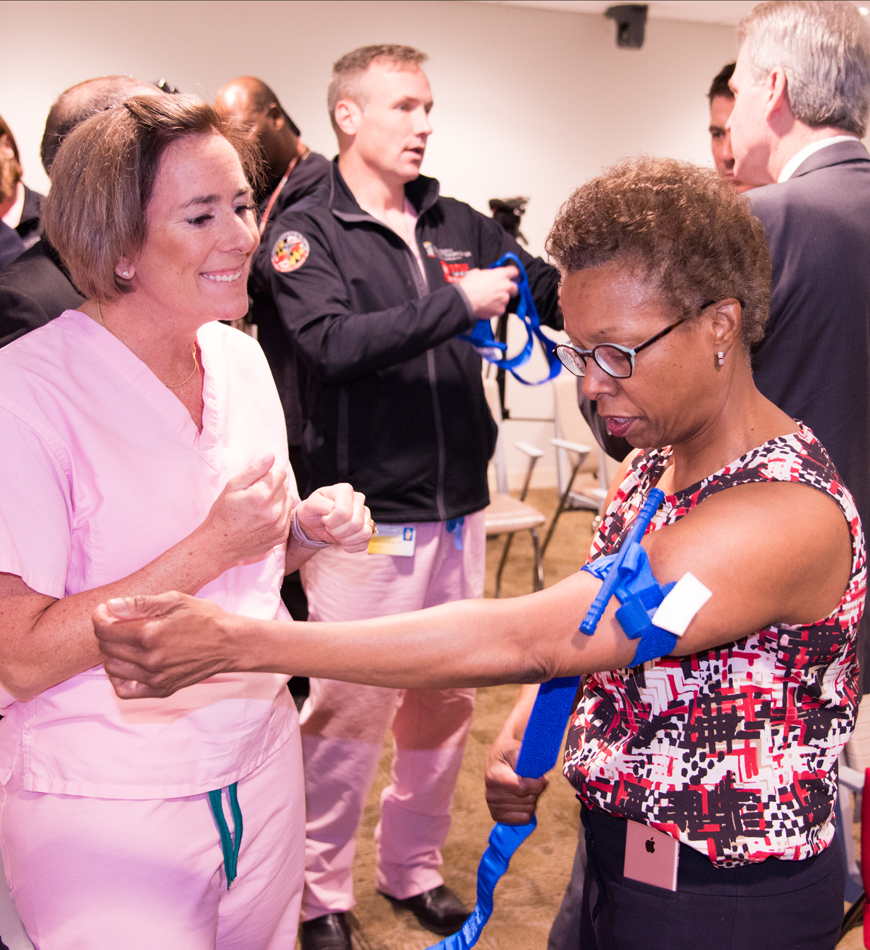The University of Maryland R Adams Cowley Shock Trauma Center provided special training on methods to control bleeding as part of the “Stop the Bleed” campaign, a national effort to teach basic bleeding control.
View a photo gallery on Facebook or a photo gallery on Flickr and see a video below.
"This is an important thing for people to know,” said Thomas Scalea, MD, The Hon. Francis X. Kelly Distinguished Professor in Trauma Surgery, director of the Program in Trauma, and physician-in-chief for the Shock Trauma Center.

Natalie Eddington, PhD, FAAPS, FCP, professor and dean of the University of Maryland School of Pharmacy, learns tourniquet techniques during "Stop the Bleed" training at the University of Maryland R Adams Cowley Shock Trauma Center.
Bleeding is the top cause of preventable death in trauma cases. Trauma experts estimate that 20 percent of people who have died from traumatic injuries could have survived with fast action to control the bleeding.
Scalea opened up the special training, held March 30, with a presentation for top leadership from the University of Maryland, Baltimore (UMB) as well as the University of Maryland School of Medicine (UMSOM), University of Maryland School of Nursing (UMSON), University of Maryland Francis King Carey School of Law, University of Maryland School of Dentistry (UMSOD), University of Maryland School of Pharmacy (UMSOP), and the Graduate School.
Campus leaders attending the training were: UMB President Jay A. Perman, MD; E. Albert Reece, MD, PhD, MBA, executive vice president for medical affairs at UMB, John Z. and Akiko K. Bowers Distinguished Professor, and dean of UMSOM; Natalie Eddington, PhD, FAAPS, FCP, dean of UMSOP; Donald Tobin, JD, dean of Maryland Carey Law; Jane Kirschling, PhD, RN, FAAN, dean of UMSON; Bruce Jarrell, MD, FACS, executive vice president, provost, and dean of the Graduate School; Mark Reynolds, DDS, PhD, MA, dean and professor of UMSOD; Tara Carlson, MD, RN, director of community outreach and external affairs for the Shock Trauma Center; and Laura Kozak, MA, associate vice president, UMB Office of Communications and Public Affairs.
Other top faculty involved in the training included Sharon Henry, MD, the Anne Scalea Professor in Trauma and director of the Division of Wound Healing and Metabolism; Jose J. Diaz, MD, CNS, FACS, FCCM, professor of surgery, vice chair, quality and safety, Department of Surgery, chief of Acute Care Surgery, and program director of the Acute Care Surgery Fellowship at the Shock Trauma Center; and Habeeba Park, MD, assistant professor, Department of Surgery and lead physician for "Stop the Bleed."
“People in the field can make the difference between life and death,” Scalea told the group before leaders received hands-on training with tourniquets and using different forms of pressure.
Jarrell tried out the skills needed for self-application of a tourniquet, as if the wound were on his own arm. Eddington took on a similar challenge. Tobin said he welcomed the training being offered to those with a non-medical background and noted how the approach differed from protocols taught during lifeguard training in his youth.
Perman said the skills are valuable throughout the University and beyond. "All of us, not just medical professionals, need to be prepared to help on the spot. We've all learned about the importance of being capable in CPR; we ought to be capable with regard to hemorrhage."


